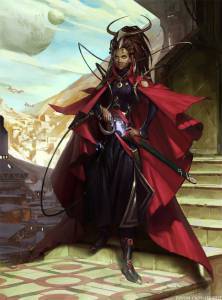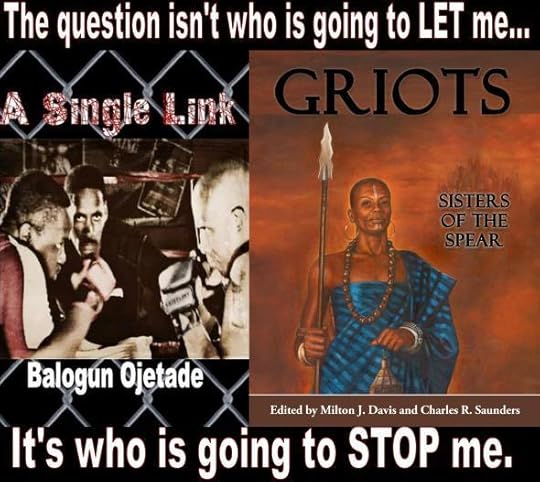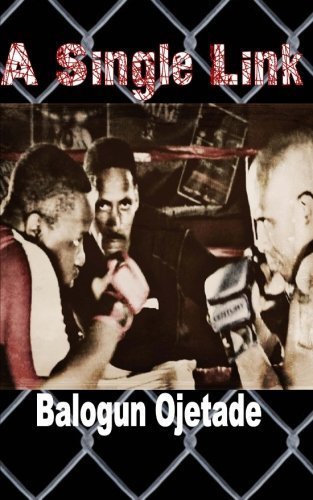Balogun Ojetade's Blog, page 21
January 9, 2014
BUILDING BLACK YOUTH THROUGH SCIENCE FICTION & FANTASY
BUILDING BLACK YOUTH THROUGH SCIENCE FICTION & FANTASY
Renowned Author, Neil Gaiman (the novel, American Gods; The Sandman comic book series) shared a fascinating fact. While appearing as Guest of Honor at China’s largest state approved Science Fiction convention, Neil decided to inquire why Science Fiction, once frowned upon by the Chinese government, was now not only approved of, but encouraged, with China now the world’s largest market for Science Fiction, with the highest circulation of Science Fiction magazines and the largest Science Fiction conventions.
The answer Neil was given is very interesting.
China is the world’s manufacturing powerhouse. But it doesn’t invent or design most of the things it manufactures. China wants to capture the creativity and imagination of the culture that has produced companies like Google and Apple. So Chinese researchers talked to people involved with those and other companies to see what factors they had in common. The answer?
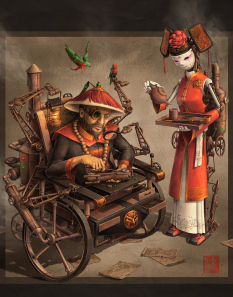
Artwork by James Ng
The Chinese acted upon this research and today, throughout China, Science Fiction is a thriving and respected genre, read widely; which is very different from the early eighties, when Science Fiction was declared to be “spiritual pollution” and banned by the government. Back then, Science Fiction in China all but disappeared. But it has come back stronger than ever, appealing to a new generation of Chinese who see themselves as part of a world-wide cultural phenomenon, which includes Hip Hop, Fashion, Movies and Science Fiction.
In the past decade, Science Fiction has overtaken fantasy as the popular literary form, even though fantastic fiction is an integral part of the history of Chinese literature.
Science Fiction studies continue at Beijing Normal University, the largest research and editing center of science-fiction theory and criticism in the world. Western authors and scholars visit there often and in the future, this center is expected to be the center of international Science Fiction research.
Science Fiction is an essential influence in the development of top level creative thinkers, especially those dealing with technology. We live in an age of unparalleled technological development, which is creating change throughout society of an unprecedented magnitude. Science Fiction, in all its forms, is a valuable tool for helping train people to creatively work with that change.
Science Fiction does not just show us possible futures, it trains us to anticipate new technology, model how it will impact our lives and exploit that insight.
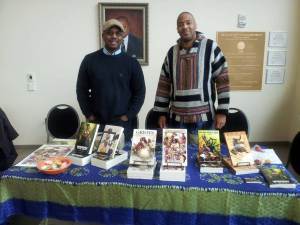 Aside from Nnedi Okorafor’s Zahrah the Windseeker and the Shadow Speaker; Wendy Raven McNair’s novels, Asleep and Awake; Alicia McCalla’s Breaking Free, Tananarive Due’s and Steven Barnes’ Devil’s Wake and Domino Falls and this writer’s own Once Upon A Time In Afrika and Moses: The Chronicles of Harriet Tubman, it is difficult to find Speculative fiction (Science Fiction and Fantasy) with Black protagonists, or even secondary characters, written for young adults by Black authors.
Aside from Nnedi Okorafor’s Zahrah the Windseeker and the Shadow Speaker; Wendy Raven McNair’s novels, Asleep and Awake; Alicia McCalla’s Breaking Free, Tananarive Due’s and Steven Barnes’ Devil’s Wake and Domino Falls and this writer’s own Once Upon A Time In Afrika and Moses: The Chronicles of Harriet Tubman, it is difficult to find Speculative fiction (Science Fiction and Fantasy) with Black protagonists, or even secondary characters, written for young adults by Black authors.
Middle Grade novels are even harder to find, with L.M. Davis’ Interlopers and Milton Davis’ Amber at the fore.
In their 2003 study of middle school genre fiction, Agosto, Hughes-Hassell, and Gilmore-Clough found that of 976 reviews of youth Fantasy novels, only 6 percent featured protagonists or secondary characters of color, and that of the 387 reviews of youth science fiction, only 5 percent featured protagonists or secondary characters of color.
Yet, as more Black authors of adult Science Fiction and Fantasy – like Charles Saunders, Walter Mosley, Keith Gaston, Valjeanne Jeffers, Milton Davis, Cerece Rennie Murphy and Balogun Ojetade (smile) – grow in popularity and fill a much needed void, more Black writers are getting the opportunity to fill that void in youth literature as well.
As the Chinese have come to realize, filling that void is important for several reasons and is a must for people of color, particularly those of African descent.
 Studies have shown that, in the general population, Science Fiction and Fantasy has an impact on the teaching of values and critical literacy to young adults. Science Fiction challenges readers to first imagine and then to realize the future of not only the novel they are reading but, also the future of the world in which they live.
Studies have shown that, in the general population, Science Fiction and Fantasy has an impact on the teaching of values and critical literacy to young adults. Science Fiction challenges readers to first imagine and then to realize the future of not only the novel they are reading but, also the future of the world in which they live.
Looking at the most visible popular examples of Epic Fantasy – J.R.R. Tolkien, Robert E. Howard and bestselling authors J.K. Rowling, George R.R. Martin and Robert Jordan – a casual observer might assume that big, continent-spanning sagas with magic in them are always set in some imaginary variation on Medieval – and, sometimes, even modern – Britain. The stories include the common tropes – swords, talismans of power, wizards and the occasional dragon, all in a world where Black people rarely exist; and those who do appear are decidedly peripheral and usually work for the bad guys.
That same casual observer might therefore conclude that Epic Fantasy – one of today’s most popular genres of fiction – would hold little interest for Black readers and even less for Black writers. But that casual observer would be wrong.
Young adults of African descent can – and do – relate to the experiences in Science Fiction and Fantasy. Indeed, they crave these experiences and read speculative fiction just as voraciously as young adults of other races. But the lack of self-images in this literature can have a negative effect on the psyche of young readers and can, indeed, contribute to negative behavior. We derive our perceptions of self by what we hear, see, and read and our perception directly affects our actions.
The Process of Action works as follows:
Perception (precedes Thought)
Thought (precedes Impulse)
Impulse (precedes Action)
Action
If the Perception of ourselves is a person who lacks courage, integrity and goodness – because we do not see ourselves possessing heroic qualities in most books – the Thought creeps into our minds that we lack those heroic qualities, so we are – by default – villains. The Thought grows into a strong Impulse to be the villain; and finally, the Action of villainy takes place.
 However, if – through Fantasy and Science Fiction written with Black characters as the heroes – our youth begin to perceive themselves as heroic…as hard working…as good…they will begin to act in accord with how they perceive themselves.
However, if – through Fantasy and Science Fiction written with Black characters as the heroes – our youth begin to perceive themselves as heroic…as hard working…as good…they will begin to act in accord with how they perceive themselves.
Above, we mentioned authors who have published books of Science Fiction and Fantasy featuring Black youth as protagonists. An analysis of these books reveals plots that are fun and adventurous; Black protagonists who are gifted, insightful youth surrounded by functional, supportive family units; and themes common to the Science Fiction and Fantasy genres, like courage, integrity, and good versus evil. While race and ethnicity are not ignored in these books, the race or ethnicity of a character does not drive the plot.
Our youth need stories that do not deny race or the historical implications of race, while remaining unhindered by the racism that may be present.
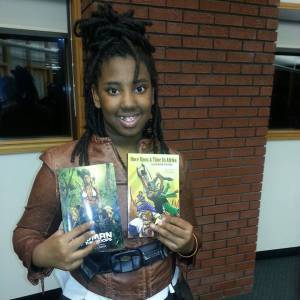 On May 5, 2012, in Atlanta, a group of Black authors of speculative fiction – in conjunction with the Auburn Avenue Research Library on African American Culture and History – came together to host The State of Black Science Fiction 2012 Youth Symposium, an amazing and day-long symposium that spotlighted Science Fiction and Fantasy as a signature intersection of science, history, technology, and humanistic studies. Fun was had by all and the students who participated, who ranged in age from 5-15, all eagerly purchased books to read during their lunch break.
On May 5, 2012, in Atlanta, a group of Black authors of speculative fiction – in conjunction with the Auburn Avenue Research Library on African American Culture and History – came together to host The State of Black Science Fiction 2012 Youth Symposium, an amazing and day-long symposium that spotlighted Science Fiction and Fantasy as a signature intersection of science, history, technology, and humanistic studies. Fun was had by all and the students who participated, who ranged in age from 5-15, all eagerly purchased books to read during their lunch break.
The symposium featured panel discussions, workshops and games that inspired the imagination and challenged minds.
The authors involved were Balogun Ojetade, Milton Davis, Alicia McCalla, L.M. Davis, Wendy Raven McNair and Ed Hall. A performance of an interactive Choose Your Own Adventure story, written by the students was featured and famed author Tananarive Due – the world’s first and most popular Black author of horror and suspense – honored us with an inspiring key-note address.
I mention the symposium because I would like to host another such conference in April or May of this year (2014). I invite my fellow authors – and anyone else who would like to become involved – to join me in creating a special event for our youth; our future.
I invite all African-centered, private and public schools who serve and care about Black youth to participate. Bring your students. Have them write works beforehand to share during the performance portion. Make it a weekend field trip. Let’s give them a day of fun, learning and transformation. Let’s give them all that speculative fiction has given us, or what it would have given us if we saw ourselves in it.
So, there it is: a full day of Black speculative fiction workshops, performances, art, games, contests and vending – all for our youth.
Are you down?


December 31, 2013
A GREAT Year for Steamfunk, Sword & Soul and Black Speculative Fiction! 2013 in review
The WordPress.com stats helper monkeys prepared a 2013 annual report for this blog.
Here’s an excerpt:
The Louvre Museum has 8.5 million visitors per year. This blog was viewed about 94,000 times in 2013. If it were an exhibit at the Louvre Museum, it would take about 4 days for that many people to see it.
Click here to see the complete report.


December 24, 2013
NO QUEENS IN AFRIKA: Women Rulers in Sword & Soul and other African-Inspired Fantasy
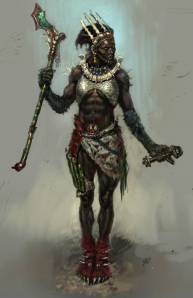 Recently, an article about the history of Nzinga, woman ruler of Angola, has surfaced and is circulating around Facebook.
Recently, an article about the history of Nzinga, woman ruler of Angola, has surfaced and is circulating around Facebook.
Now, while I am happy to see Nzinga recognized, every time I see it I cringe.
Why?
Because, the posters of that article scream “The mighty Queen Nzinga!” or “Warrior-Queen Nzinga!” or “Another great African Queen: Nzinga!” or, simply “Queen Nzinga!”
Sigh.
Nzinga was never a queen people!
No African woman ever was.
That’s right. I said it. Now, read on!
I should say that no traditional, pre-colonial, woman – or woman who opposed colonization / slavery ever was – because later, you did have some Europeanized African rulers who, in their attempts to reduce the power of women, reduced them to queens – and many women accepted their lot.
Nzinga was an Ngola – a ruler of a nation; a “king”, if you must.
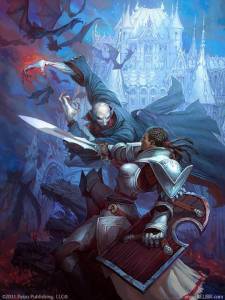 Some say she was given the title after the passing of her father, who was an Ngola. Some say Nzinga was given the title after murdering her own brother and becoming her father’s next heir to the throne. However she became Ngola, she was Ngola…not queen.
Some say she was given the title after the passing of her father, who was an Ngola. Some say Nzinga was given the title after murdering her own brother and becoming her father’s next heir to the throne. However she became Ngola, she was Ngola…not queen.
Traditional rulers throughout Africa were not always given the title and responsibilities of rule by birth or by blood. More often than not, the people chose their ruler and if the ruler did not serve and / or represent the people well, the ruler could be removed from his or her throne.
It was the people who governed and, to the people, gender was rarely a factor in who they chose to lead them.
Among the Yoruba, anyone born under the Odu – the 256 patterns of life / containers of destiny in which all creation exists – Irete Ogbe (aka Irentegbe, or Ategbe) is destined to be an Ǫba, or “king”; gender be damned.
The term “queen” is a product of recent history and the English language. In Ancient African, Asian and Pacific cultures, and even some European countries, women rulers were given the title king or its equivalent, such as pharaoh.
The Byzantine Empress Irene was called basileus – “emperor” – not basilissa, or “empress”. Jadwiga of Poland was crowned Rex Poloniae, King of Poland.
In China, Wu Zetian became the emperor and established the Zhou Dynasty after dismissing her sons. It should be noted that Emperor Wu is described throughout history as huangdi – “emperor”, as opposed to huanghou – “empress”. Similarly, in Korea, the rulers Sindeok and Jindeok were called yeowang – “female king” not hwanghu – “queen”, which refers to the wife of a king or emperor.
“Then what the hell is a queen?” You ask?
Well, let’s examine the term.
A queen regnant (plural: queens regnant) is a European female monarch who reigns in her own right, in contrast to a queen regent, also known as a queen consort, who is the wife of a reigning king.
An empress regnant is a female monarch who reigns in her own right over an empire.
A queen regnant possesses and exercises sovereign powers. The husband of a queen regnant does not usually share his wife’s rank, title or sovereignty.
A queen consort, on the other hand, shares her husband’s rank and titles, but does not share his sovereignty.
A queen dowager is the widow of a king. A queen mother is a queen dowager who is also the mother of a reigning sovereign.
Among the Davidic Monarchs of the Kingdom of Judah, there is mentioned a single queen regnant, Athaliah, though the Hebrew Bible regards her negatively as a usurper. The much later Hasmonean, Queen Salome Alexandra (Shlom Tzion), was highly popular.
Accession of a regnant occurs as a nation’s order of succession permits. Methods of succession to queendoms, kingdoms and tribal chieftancies, include nomination when the sitting monarch or a council names an heir, known as primogeniture when the children are chosen in order of birth from eldest to youngest; or ultimogeniture when the children are chosen from youngest to eldest.
Historically, many European realms forbade succession by women or through a female line in obedience to the Salic law, and some still do. No queen regnant ever ruled France, for example. Only one woman, Maria Theresa, ruled Austria.
In Japan, the Chrysanthemum Throne – currently barred to women – did not always have such a restriction. There have been eight empresses regnant. The Japanese language calls such women rulers josei tennō – “female imperial ruler” – with kōgō being the term reserved for an empress consort.
Now that you have a clearer understanding of the differences between European and African women who rule and how referring to such African women as “Queen” in your fiction is not correct and could even be considered insulting to many, let’s look at a few African women rulers for information and inspiration in your research and writings.
Amina – or Aminatu – of Zazzau (Zaria)
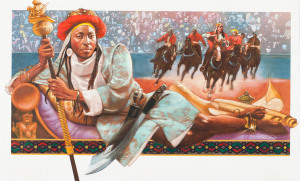 Amina was the eldest daughter of Bakwa Turunku – also a woman – the founder of the Zazzau Kingdom in 1536. After the death of her mother in 1549, Amina ascended the throne. This medieval African kingdom was located in the region now known as the Kaduna State in the north-central region of Nigeria, capital at the modern city of Zaria, named after Amina’s younger sister, Zariya.
Amina was the eldest daughter of Bakwa Turunku – also a woman – the founder of the Zazzau Kingdom in 1536. After the death of her mother in 1549, Amina ascended the throne. This medieval African kingdom was located in the region now known as the Kaduna State in the north-central region of Nigeria, capital at the modern city of Zaria, named after Amina’s younger sister, Zariya.
The earliest commentator to mention Amina is Muhammed Bello’s history text, Ifaq al-Maysur, composed around 1836.
Amina is also mentioned in the Kano Chronicle, a well-regarded and detailed history of the city of Kano and the surrounding Hausa people.
Known as a great military strategist, the cavalry-trained Amina fought many wars that expanded the southernmost Hausa kingdom.
Queen Amina is a legend among the Hausa people for her military exploits. She controlled the trade routes in the region, erecting a network of commerce within the great earthen walls that surrounded Hausa cities within her dominion. According to the Kano Chronicle, she conquered as far as Nupe and Kwarafa, ruling for 34 years.
Moremi Ajasoro, Olori of Ile Ife
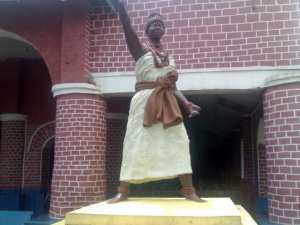 Moremi Ajasoro was a figure of high significance in the history of the Yoruba people of Southwest Nigeria, Benin and Togo. She was a member, by marriage of the of the royal family of Emperor Oduduwa, the progenitor of the Yoruba people (whom some scholars believe was a woman).
Moremi Ajasoro was a figure of high significance in the history of the Yoruba people of Southwest Nigeria, Benin and Togo. She was a member, by marriage of the of the royal family of Emperor Oduduwa, the progenitor of the Yoruba people (whom some scholars believe was a woman).
Moremi was an Olori – a title held only by certain Chiefs – hailing from Ile Ife, a kingdom at war with the neighboring Ìgbò nation.
Scores of Ife – or citizens of the Kingdom of Ile Ife – were enslaved by the Ìgbò. Because of this, the Ìgbò were generally regarded with disdain by the Yoruba city-states.
Moremi – a very brave and beautiful woman – was taken and enslaved by the Ìgbò and, due to her beauty, was wed to their ruler.
After familiarizing herself with the secrets of her new husband’s army, Moremi escaped to Ile Ife and revealed these secrets to the Yoruba, who were able to subsequently defeat the Ìgbò in battle.
Following the war, Moremi returned to her first husband, King Oranmiyan of Ile Ife.
Oranmiyan immediately had Moremi re-instated as his wife and as a Chief.
In contemporary Nigeria, a number of public places are named after Moremi, such as the women’s residence halls at the University of Lagos and Obafemi Awolowo University.
Hatshepsut
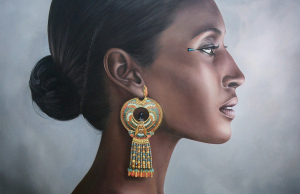 Hatshepsut – meaning “Foremost of Noble Ladies” – was the fifth pharaoh of the eighteenth dynasty of Ancient Egypt. She is generally regarded by Egyptologists as one of the most successful pharaohs, reigning longer than any other woman of an indigenous Egyptian dynasty. She is also known to scholars as “the first great woman in history of whom we are informed.”
Hatshepsut – meaning “Foremost of Noble Ladies” – was the fifth pharaoh of the eighteenth dynasty of Ancient Egypt. She is generally regarded by Egyptologists as one of the most successful pharaohs, reigning longer than any other woman of an indigenous Egyptian dynasty. She is also known to scholars as “the first great woman in history of whom we are informed.”
Although it was uncommon for Egypt to be ruled by a woman, the situation was not unprecedented. Hatshepsut was preceded by Merneith, of the first dynasty; Nimaethap, of the third dynasty; Nitocris, the last pharaoh of the sixth dynasty; Sobekneferu, of the twelfth dynasty; and the warrior, Ahotep I.
In comparison with other women pharaohs, Hatshepsut’s reign was much longer and much more prosperous. She was successful in warfare early in her reign, but generally is considered to be a pharaoh who inaugurated a long peaceful era. Hatshepsut reestablished international trading relationships, once lost during a foreign occupation, and brought great wealth to Egypt – wealth that enabled her to initiate building projects that raised the caliber of Ancient Egyptian architecture to a standard that would not be rivaled by any other culture for a thousand years. Hatshepsut ruled for twenty-two years.
Ngola Nzinga Mbandi
 Nzinga Mbandi was a ruthless and powerful ruler of the Ndongo and Matamba Kingdoms, which is now the nation of Angola.
Nzinga Mbandi was a ruthless and powerful ruler of the Ndongo and Matamba Kingdoms, which is now the nation of Angola.
Nzinga fearlessly and cleverly fought for the freedom and stature of her kingdoms against the Portuguese, who were colonizing the area at the time.
Around the turn of the 17th century, the independent kingdoms and states of the Central African coast were threatened by Portuguese attempts to colonize Luanda, today the capital of Angola.
Portugal sought to colonize the region in order to control the trade in African slaves, and attacked many of their old trading partners to further this goal.
Unlike many other rulers at the time, Nzinga was able to adapt to these changing circumstances and fluctuations in power around her. By her own determination and refusal to give in to the Portuguese without a fight, she transformed her kingdom into a formidable commercial state on equal footing with the Portuguese colonies.
In 1617 the new Portuguese governor of Luanda began an aggressive campaign against the kingdom of Ndongo. His troops invaded the capital and forced Ngola Mbandi – Nzinga’s brother, who inherited the throne from their father – to flee from the area. Thousands of Ndongo people were taken prisoner.
The Ngola sent his sister Nzinga Mbandi to negotiate a peace treaty in 1621, which she did successfully. But Portugal didn’t honor the terms of the treaty.
Ngola Mbandi, feeling he had failed his people, committed suicide, leaving the kingdom to his sister, Nzinga.
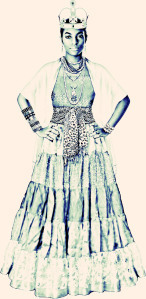 As the new sovereign of Ndongo, Nzinga re-entered negotiations with the Portuguese. At the time, Ndongo was under attack from both the Portuguese and neighboring African aggressors. Nzinga realized that in order to achieve peace and for her kingdom to remain viable, she needed to become an intermediary. She allied Ndongo with Portugal, and was baptized as Ana de Sousa Nzinga Mbande, with the Portuguese colonial governor serving as her godfather. By doing this she acquired a partner in her fight against her African enemies, and ending Portuguese slave raiding in the kingdom.
As the new sovereign of Ndongo, Nzinga re-entered negotiations with the Portuguese. At the time, Ndongo was under attack from both the Portuguese and neighboring African aggressors. Nzinga realized that in order to achieve peace and for her kingdom to remain viable, she needed to become an intermediary. She allied Ndongo with Portugal, and was baptized as Ana de Sousa Nzinga Mbande, with the Portuguese colonial governor serving as her godfather. By doing this she acquired a partner in her fight against her African enemies, and ending Portuguese slave raiding in the kingdom.
The new alliance didn’t last very long, however. Portugal betrayed Ndongo in 1626, and Nzinga was forced to flee when war broke out. Nzinga took over as ruler of the nearby kingdom of Matamba, capturing Matamba’s ruler – a woman by the name of Mwongo Matamba – and routing her army. Nzinga then made Matamba her capital, joining it to the Kingdom of Ndongo.
To build up her kingdom’s martial power, Nzinga offered sanctuary to runaway slaves and Portuguese-trained African soldiers and stirred up rebellion among the people still left in Ndongo, now ruled by the Portuguese.
Nzinga also reached out to the Dutch and invited them to join troops with her. She told the Dutch she would be happy to ally with them because of their justice and politeness, whereas the Portuguese were proud and haughty.
Even their combined forces were not enough to drive the Portuguese out, however, and after retreating to Matamba again, Nzinga started to focus on developing Matamba as a trading power and the gateway to the Central African interior.
By the time of Nzinga’s death in 1661 at the age of 81, Matamba was on equal footing with the Portuguese colony. The Portuguese came to respect Ngola Nzinga for her shrewdness and tenacity.
Now, please, no more excuses. If you are writing Sword and Soul, building an African setting for your Fantasy Role-Playing Game, or hell, writing an essay on an African ruler who happens to be a woman, please, do your research. Get it right.
And for all you players and smooth-talkers, the next time you open your mouth to call a sister a “beautiful African Queen”…don’t.
Beautiful African King, maybe. But if that doesn’t sound right to you, although it’s much more accurate, hell, just go with Goddess. Yeah, that’s it.
Goddess.


December 17, 2013
MORE TROLLS THAN A MID-LEVEL DUNGEONS AND DRAGONS CAMPAIGN
MORE TROLLS THAN A MID-LEVEL DUNGEONS AND DRAGONS CAMPAIGN
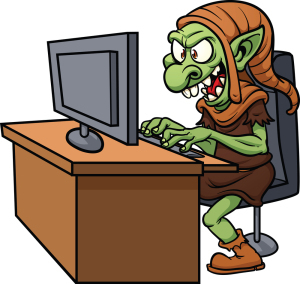 I have been the victim of trolling.
I have been the victim of trolling.
Recently, a person tried to bait me into an argument, or get a rise out of me by insulting my latest book release, A Single Link, without reading it. When that didn’t work, they said they were purchasing another book that released the same day as A Single Link.
Fine by me; my short story, Brood is in that book, too.
Silly rabbit.
No, not rabbit…troll.
In Internet slang, a troll is a person who sows discord on the Internet by starting arguments or upsetting people by posting inflammatory, extraneous, or off-topic messages in an online community, such as a group forum, chat room, or blog.
While trolling – the term for the discordant actions of a troll – can be accidental, it is usually done with the deliberate intent of provoking readers into an emotional response or of otherwise disrupting normal on-topic discussion.
Media attention in recent years has equated trolling with online harassment and bullying. For example, mass media has used troll to describe “a person who defaces Internet tribute sites with the aim of causing grief to families.”
 The advice “Please don’t feed the troll,” is often given, which means to ignore trolls and their actions.
The advice “Please don’t feed the troll,” is often given, which means to ignore trolls and their actions.
Of course, trolls are not limited to English-speaking countries. Every nation on Earth is plagued by the trollpocalypse.
In Taiwanese Mandarin, trolling is referred to as bái mù – literally, “white eye” – or, “eyes without pupils”. The pupil of the eye is used for vision; the white part of the eye cannot see. In regard to trolls, this means that trolling involves blindly talking nonsense over the internet, with no regard for others. The alternative term is bái làn – literally “white rot” – which describes an internet post that is completely nonsensical and full of folly made to upset others. It derives from a Taiwanese slang term for pale, white, male genitalia, considered to be the genitalia of someone who is young and foolish.
In Japanese, tsuri means “fishing” and refers to posts with the sole purpose of getting readers to react.
In Icelandic, þurs refers to trolls. The verbs þursa (to troll) or þursast (to be trolling, to troll about) are also used.
In Korean, nak-si means “fishing”, and is used to refer to Internet trolling, as well as to purposefully misleading post titles.
 In Thai, the word krean – the name of a closely cropped hairstyle worn by school boys in Thailand – is used to address Internet trolls, thus equating them with school boys. The phrase tob krean, or “slapping a cropped head”, refers to the act of posting intellectual replies to refute and the messages of Internet trolls and cause them to be perceived as unintelligent.
In Thai, the word krean – the name of a closely cropped hairstyle worn by school boys in Thailand – is used to address Internet trolls, thus equating them with school boys. The phrase tob krean, or “slapping a cropped head”, refers to the act of posting intellectual replies to refute and the messages of Internet trolls and cause them to be perceived as unintelligent.
Psychologists have discovered that trolling is a form of symbolic violence. Trolls desire to promote antipathetic emotions of disgust and outrage, which gives them a morbid sense of pleasure.
The troll is a predator who attempts to pass as a legitimate participant in a group, sharing the group’s common interests and concerns. A group’s success at detecting a troll depends on how well they – and the troll – understand identity cues.
And trolls must be identified and, upon identification, immediately banned from the group or unfriended because trolls can be costly in several ways:
A troll can disrupt a discussion, disseminate bad advice and damage the feeling of trust in the group or community. Furthermore, in a group that has become sensitized to trolling – where the rate of deception is high – many honestly naïve questions may be perceived as trolling and the questioner branded a troll.
“Why would someone in their right mind troll?” You ask?
 Because they are not in their right mind. Predators – unless they are lions, tigers, or hawks or something – rarely are.
Because they are not in their right mind. Predators – unless they are lions, tigers, or hawks or something – rarely are.
Most are bullies. Punk-ass bullies, at that.
These e-gangsters and keyboard killers are more aggressive, rude and forthright online because they are anonymous and can act as unpleasantly as they like without immediate consequence.
In real life, though, these chumps wouldn’t clap at a concert, because pulling the same shit would, at best, incur social sanctions and at worst, incur an ass whoopin’.
“Other than moderation and censorship, what can we do to stop these damned trolls?” You ask?
Well, let’s go to the experts on trolls – Dungeons and Dragons – and see what they have to say (the emphasis, in bold, is mine).
“With its 5 hit points of regeneration per round, a troll can stand up to a lot of punishment. Moreover, it has 10 feet of reach that allows it get the drop on Player Characters with attacks of opportunity, as well as two claws and a bite attack for significant Strength-enhanced damage.
 Trolls are horrid carnivores found in all climes, from arctic wastelands to tropical jungles. Most creatures avoid these beasts, which know no fear and attack unceasingly when hungry.
Trolls are horrid carnivores found in all climes, from arctic wastelands to tropical jungles. Most creatures avoid these beasts, which know no fear and attack unceasingly when hungry.
Trolls have ravenous appetites, devouring everything from grubs to bears and humanoids. They often lair near settlements and hunt the inhabitants until they devour every last one…trolls can appear thin and frail but possess surprising strength
They launch themselves into combat without hesitation , flailing wildly at the closest opponent.
Trolls are infamous for their regenerative abilities, able to recover from the most grievous of wounds or regenerate entire limbs given time. Severing a troll’s head results merely in temporary incapacitation, rather than death. After cutting off a troll’s head or other limbs, one must seal the wounds with fire or acid to prevent regeneration. Because of this, most adventurers will typically carry some sort of implement capable of creating fire.”
“…After cutting off a troll’s head or other limbs, one must seal the wounds with fire or acid to prevent regeneration.” As I stated earlier, you must identify the troll, cut them off from communication with the group, or yourself, and then permanently ban them and warn others against the troll, thus “cauterizing” the wound caused by their actions.
So, hunt down those trolls, draw your +3 keen Vorpal Sword and decapitate that predatory little bastard.
Be sure you have a torch or a vial of acid handy, though.
Can’t have that troll growing a new head and coming back.
*DISCLAIMER: I do not condone the literal decapitation of anyone, not even trolls…unless, of course, it is in self-defense, or it is an actual out-from-under-the-bridge troll.


December 13, 2013
AFRICAN PULP: The Spear in Racist Pulp Fiction’s Heart!
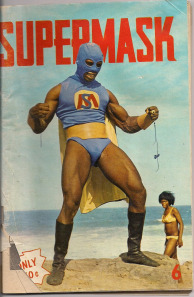 Throughout Africa, storytelling has always been an intrinsic part of society, used to recall historical events, impart wisdom, debate and communicate messages from the divine.
Throughout Africa, storytelling has always been an intrinsic part of society, used to recall historical events, impart wisdom, debate and communicate messages from the divine.
Storytellers – called Djele, Sanusi, Babalawo, Iyanifa, Okomfo and other titles, depending on where, on the continent you go – are revered and are usually also skilled in spiritual and healing practices as well.
Tales of powerful heroes, megalomaniacal villains, sorcerers, witches and fearsome creatures abound in African folklore, thus I was not surprised at my recent discovery – thanks to Paul Bishop, author and mastermind behind the Fight Card brand of Fight Fiction books – that Pulp magazines, created by, and about, African heroes were highly popular across the continent in the 1960s through the 1980s.
Sold under the brand names African Film and Boom, these magazines – called photo comics, or “look books” – were illustrated with stunning photographs instead of drawings, giving them the uniqueness, creative flair and do-it-yourself spirit common throughout Africa.
With heroes like the Tarzanesque Fearless Fang (Boom) and the “African Superman”, Son of Samson, children and adults alike waited eagerly every month for latest edition to hit the newsstands.
 The most popular photo comic magazine was The Spear (African Film), which featured Lance Spearman, the super-spy / detective whose coolness James Bond and Derek Flint would envy. The Spear drove a Corvette stingray, sported a panama hat and well-tailored suits with a bow tie and smoked expensive cigars. And in true Pulp fashion, he had a bevy of beautiful women at his beck-and-call.
The most popular photo comic magazine was The Spear (African Film), which featured Lance Spearman, the super-spy / detective whose coolness James Bond and Derek Flint would envy. The Spear drove a Corvette stingray, sported a panama hat and well-tailored suits with a bow tie and smoked expensive cigars. And in true Pulp fashion, he had a bevy of beautiful women at his beck-and-call.
Lance Spearman pursued the bad guys with zeal, outwitting their conspiracies, kicking much ass with his African martial arts and saving the day…all in one issue!
These popular Pulps – a portfolio of black and white photos, complete with speech balloons, narration boxes and all the “bam-pow” sound effects that a kick and a quick upper cut to the jaw makes in any comic book.
Unlike the popular Pulps of the Western world, however, which were rife with racist tropes of uncivilized, uneducated, spear-chucking cannibals, or damn-near naked noble savages, with objectified, ample body parts, Lance Spearman was sharp, stylish and sophisticated.
Even the jungle stalking Fearless Fang was intelligent, witty, brave and well, cool.
Combining Western references with a distinctly African cultural identity, these amazing African Pulps presented a critique of colonialism and a significant variation in how the genre classically figured normality and otherness.
And they were entertaining as hell!
Published first by publisher Drum Publications in Nigeria in the early 1960s and later also published in Kenya and Ghana the photo comic had a powerful and lasting influence in fostering postcolonial pride and identity.
Its combination of extreme violence, melodrama, romance and glimpses of the glamorous life preceded and influenced the Blaxploitation craze in American cinema in the 1970s and its use of inventive DIY tactics to overcome budget constraints influenced the booming Nollywood film industry.
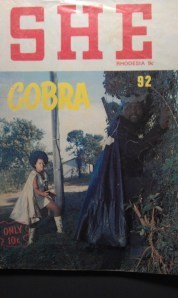 Other popular titles included The Stranger, about a two-gun toting, Black Lone Ranger-type hero; the romantic Sadness and Joy; and the serpentine shero, Cobra.
Other popular titles included The Stranger, about a two-gun toting, Black Lone Ranger-type hero; the romantic Sadness and Joy; and the serpentine shero, Cobra.
“Ok, you’ve told us about the photo comics, but how, and why, were they created?” You ask? “
Well, Drum Publications of Nairobi, Kenya – tired of the clichéd racist images of Black people in contrast to the heroic images of white soldiers and superheroes in Western comics – decided to create comic books that would appeal to Black men. They began photographing black men in adventures that were designed to appeal to the Black African population.
Drum would buy stories and then send the scripts to Swaziland, where a photographer would takes pictures of a cast of Black actors. They would then send the photographed strips to London, England, where the magazines were printed. Finally, the photo comic magazines would be distributed in West, East and South Africa.
 The Lance Spearman title was the most popular publication, with circulation figures estimated at 100, 000 in West Africa, 45,000 in East Africa and 20,000 in South Africa. In fact, Lance Spearman had a greater circulation in Kenya than any of the local daily newspapers at that time.
The Lance Spearman title was the most popular publication, with circulation figures estimated at 100, 000 in West Africa, 45,000 in East Africa and 20,000 in South Africa. In fact, Lance Spearman had a greater circulation in Kenya than any of the local daily newspapers at that time.
The writers of these look-books were Black Africans, who were paid $65 – equivalent to approximately $508.00 today – for every script they produced.
Expected in the scripts were lots of fistfights and the bad guys always losing in the end.
The readership of these photo comics included men, women, boys and girls from small rural towns to sprawling urban cities; from the barely literate to highly educated professionals.
The man, who played the character of Lance Spearman, was Jore Mkwanazi, originally employed as a “houseboy” in Durban, South Africa, scrubbing the floors of an apartment for $35 a month and as a musician, playing the piano in a nightclub for $1.50 a night, when photographer Stanley N. Bunn discovered him and decided he had the tough, cynical, sophisticated face that was needed for The Spear. In the role of the super-spy, Mkwanazi earned $215 a month.
Here is the original Drum Publications information, found in every issue of their photo comic magazines:
Drum Publications (E.A.) Ltd
P.O Box 43372
Nairobi
Kenya
Editor: J. Singh
Printed by
Printing and Packaging Corporation Ltd
P.O Box 30157,
Nairobi
But the story of photo comic magazines does not stop here.
In fact, it is just beginning.
In the summer of 2014, I will publish my first photo comic book, The Siafu: Revolution.
The Siafu is about escaped prisoner, Jamil Brown, who suffers a virus-induced myostatin deficiency that gives him enhanced strength, speed and endurance. Jamil is hunted by his makers, while gathering others like him to help fight against the corrupt system that made him.
For those of you who don’t know, siafu are army ants that, while small, are powerful and – in large enough numbers – can bring down an elephant.
So, be on the lookout for this amazing new graphic Pulp science fiction novel in a few months.
Get ready for The Siafu.
Get ready for Revolution.


December 11, 2013
THIS AINT I SPIT ON YOUR GRAVE: Rape in Black Speculative Fiction!
THIS AINT I SPIT ON YOUR GRAVE: Rape in Black Speculative Fiction
 As I write this, I think of the sad fact that three of my seven daughters – I have eight children; two grandchildren – have been raped. I, too, was raped as a little boy, by a woman.
As I write this, I think of the sad fact that three of my seven daughters – I have eight children; two grandchildren – have been raped. I, too, was raped as a little boy, by a woman.
For years, I worked as an expert witness on violent crime in Illinois and I am the founder of the NZINGA: Mother / Daughter Self-Defense Program, in which I taught rape awareness as part of the course. I say taught, because I have since given responsibilities of that program over to my wife and to the women who are Assistant Instructors under my tutelage.
Among African Americans, there is a reluctance to report rape and incest. A reluctance born of wariness of authority, especially white authority, which is learned from the experience of white lynch mobs; the death of four little girls killed during the bombing of a church in Birmingham and the battered body of young Emmett Till. There is reluctance, because we remember the destruction of entire cities – such as Tulsa, Oklahoma and Rosewood, Florida – at the hands of white mobs after a Black man was wrongfully accused of raping a white woman.
Historically, we have learned that the system is not to be trusted.
Rape is one of the most underreported violent crimes, according to the Department of Justice, regardless of the victim’s sex, age, race, ethnicity, religion or class, but as a group, African American women are the least likely to break the silence.
This phenomenon, first documented in 1981 by Gail Wyatt, a sexual behavior researcher at the UCLA Neuropsychiatric Institute, is now being addressed in self-help books and at rape crisis centers created specifically to serve People of Color, such as the Rosa Parks Sexual Assault Crisis Center in South Los Angeles.
I believe what I suffered, which I kept to myself for thirty years, led me to being sexually promiscuous at a very young age; to high blood pressure, which led to several strokes in 2012 and a bout with alcoholism. What I, three of my children and countless women I know, suffered also led to my portraying rapists, or potential rapists, as the vilest of villains in some of my writing.
It’s no secret that rape is common in fiction. Sometimes it’s relevant to the plot, often used as the catalyst in a revenge story. Other times rape is used to remind us that we live in a cruel world, filled with even crueler people. And other times, it is used to shock, or even titillate.
 I don’t write much about rape. Only my latest book, A Single Link, actually has such a horrific event take place and in one of my screenplays, I hint that one of the villains is a rapist.
I don’t write much about rape. Only my latest book, A Single Link, actually has such a horrific event take place and in one of my screenplays, I hint that one of the villains is a rapist.
When I wrote A Single Link, which I first wrote, directed and produced as a film, I conferred with nearly fifty women of various ages. I asked if I had handled the rape intelligently, if it came off as a gimmick, or if it was predictable. They invariably answered “no,” and told me A Single Link was a story that needed to be told.
Many of the women – including my wife – gave suggestions on how I could make the story more believable; more like something they would want to see. I am glad I listened and made much needed changes based on their suggestions. The story went through fifteen drafts – more than I have ever done for any of my writing – before I was comfortable enough with the script to shoot it.
I am happy I did.
Many lazy writers use rape as a plot device in their stories because it is easy to use as a motivator for the shero to begin her quest. Well, for those who have known me for even a short while, you know I am far from lazy, so you know that was not my motivation (as one reader and part-time troll implied). She assumed my use of the rape is predictable…which is a predictable – and lazy – response, by the way (do your research – or at least read the book – before passing judgment, y’all).
However, to be fair, rape is often overused or misused in fiction; particularly in Science Fiction and Fantasy.
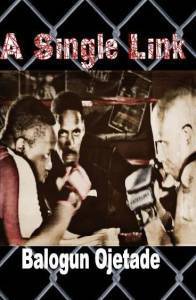 Rape should not be used unless its occurrence is integral to the development of the story or a character.
Rape should not be used unless its occurrence is integral to the development of the story or a character.
In fact, no violent act – assault; battery; terroristic threats; murder — should take place in a story unless it is integral to the plot or to develop characters. Any violence, for the sake of violence, is wrong and makes for poor writing.
A common statement that has been made is “Let’s see men get raped in fiction as well.” Once again, if it is handled intelligently and with empathy, why not? However, if such a story is told on some old ‘quid pro quo’ bull, then it is just as gimmicky; just as lazy; just as wrong.
Rape of men has happened in popular fiction a few times; most famously in Pulp Fiction, Deliverance and Antwone Fisher. Sadly, these rapes have been made jokes of by men and women, as if a man suffering a rape – especially if committed by a woman – has no lasting effect on men. This should be rectified, so I would welcome someone writing a story that deals with this issue seriously.
America has been described as a “rape culture” – an environment in which rape is prevalent and in which sexual violence against women is normalized and excused in the media and popular culture through the use of misogynistic language, the objectification of women’s bodies, and the glamorization of sexual violence – and I would agree with that description.
A Single Link is my contribution to the fight against such a twisted, cruel culture that leaves my mother, my sisters, my daughters, and even my son, unsafe.
I pray I got it right.
Read the book and let me know.


December 9, 2013
SISTERS OF THE SPEAR: Black Sheroes In Speculative Fiction
A while ago, I wrote a blog lamenting the sexism in speculative fiction. We still have a long way to go, but, in Black Speculative Fiction, at least, great strides are being made to give women their due respect and some awesome sheroes have emerged.
In this festive month, alone, no less than two awesome books have been released that feature hard-hitting women protagonists:
The first is the Sword and Soul anthology, Griots: Sisters of the Spear, which picks up where the ground breaking Griots anthology leaves off. Charles R. Saunders and Milton J. Davis present seventeen original and exciting Sword and Soul tales focusing on Black women as sheroes. Just as the Griots anthology broke ground as the first Sword and Soul anthology, Griots: Sisters of the Spear pays homage to the spirit, bravery and compassion of Black women. The griots have returned to sing new songs; and what wonderful songs they are!
The Table of Contents and list of authors in Sisters of the Spear hints at just how much of an amazing must-read this anthology is:
A Subtle Lyric by Troy L Wiggins
Blood of the Lion by Joe Bonadonna
Brood by Balogun Ojetade
Death and Honor by Ronald Jones
Ghost Marriage by Phenderson Djèlí Clark
Lady of Flames by Treka Willis Cross
Marked by Sara Macklin
Queen of the Sapphire Coast by Linda Macauley
Raiders of the Skye Isle by Cynthia Ward
The Antuthema by Ds Brown
The Night Wife by Carole McDonnell
The Price of Kush by Sylvia Kelso
The Sickness by Valjeanne Jeffers
Zambeto by JC Holbrook
Old Habits by Milton Davis
Kpendu (a new Dossouye story) by Charles Saunders

Art by Andrea Rushing.
The women in this book are brave, strong, powerful and brilliant. In my story, Brood, the shero is Mistress Oyabakin, the most powerful warrior on the continent and one of the main characters in the Sword and Soul novel, Once Upon A Time In Afrika.
The second book is the two-fisted (and footed; and elbowed; and kneed) action-adventure Fight Fiction / New Pulp tale, A Single Link.
After suffering a brutal rape at the hands of a martial arts champion, Remi “Ray” Swan decides that, to gain closure and empowerment, she must face her attacker in the first professional fight between a man and a woman.
In A Single Link, the author, Balogun Ojetade (yep, Yours Truly) challenges you to step into the cage, where action, adventure, bone shattering fights, and a touch of romance await you!
Remi Swan, who goes on to become known as ‘The Single Link’ when she transitions from receptionist at a martial arts school to pro fighter must earn her spot on the fight cards, battling not only men, but a formidable women’s champion, who feels Remi has no place in the sport of professional mixed martial arts at all.
Remi is a wife, a mother and a martial artist who lives in a near-future world in which mixed martial arts has become a sport more popular than soccer and basketball. A near-future that dares ask and examine the questions “can a woman win against a man in a professional fight?”
 This fast-paced, hard-hitting tale is the first in a series of books I call the WERK Chronicles. Also, set within the WERK (World Extreme Ring Kombat) Chronicles universe, but not directly part of the WERK Chronicles itself, is Fists of Africa, the Fight Fiction New Pulp novella I penned as part of the Fight Card MMA series. Fists of Africa will release in early 2014.
This fast-paced, hard-hitting tale is the first in a series of books I call the WERK Chronicles. Also, set within the WERK (World Extreme Ring Kombat) Chronicles universe, but not directly part of the WERK Chronicles itself, is Fists of Africa, the Fight Fiction New Pulp novella I penned as part of the Fight Card MMA series. Fists of Africa will release in early 2014.
Another WERK Chronicles book featuring Remi ‘The Single Link’ Swan – Showdown in Sudan – will release in summer, 2014.
I’d like to introduce you to a few more powerful sisters in fiction:
In the Vampire Huntress Legend Series, a twelve book series written by L.A. Banks, we meet young, African-American spoken word artist named Damali Richards, who is one of the Neteru, humans born every thousand years to fight creatures from the Dark Realms. Her most dangerous and most constant enemies from the Dark Realms are vampires. Damali was orphaned at an early age and her experiences in foster care led her to escape, starting her journey as a vampire huntress.
The first book in this incredible series, Minion, unfolds Damali’s origin and introduces us to her team of fellow hunters.
In the Immortal series by Valjeanne Jeffers, the shape-shifting Karla emerges. Karla is described as a young, “Indigo” (read the book to find out what an Indigo is) woman who works as a successful healer at a place called CLEAN, where people go to get “clean” from addiction to the legal drugs Rush and Placid. Karla is tormented by lucid and erotic – yet terrifying – dreams in which she is immortal.
Two men emerge from these phantasms: the first a Copper shape-shifter (again, read the book) and the other a demon more dead than alive. But Karla is more than prepared to deal with the dark creatures from her dreams…if her own lust doesn’t consume her first.
Parable of the Sower centers on a young woman named Lauren Olamina, who possesses what author Octavia Butler dubbed “hyperempathy”, the ability to feel the pain – and other sensations – of others. As a child living in the remnants of a gated community in post-apocalyptic Los Angeles, Lauren develops a benign philosophical and religious system called “Earth seed”.
Society has reverted to anarchy due to scarce resources and poverty. When the community’s security is compromised, Lauren’s home is destroyed and her family is murdered. She travels north with a few other survivors to start a community where Earth seed can grow.
Dossouye is the tale of the warrior Dossouye and her war-bull, Gob, written by the father of Sword and Soul, Charles R. Saunders.
This fierce and fearsome character is inspired by the real-life female warriors of the West African Kingdom of Mahoney.
Orphaned at a young age, Dossouye becomes a soldier in the women’s army of the kingdom of Anomy. In a war against the rival kingdom of Avanti, Dossouye saves her people from certain destruction; but a cruel twist of fate compels her to go into exile.
On her journey across the vast rainforests outside of her homeland, Dossouye encounters many menaces and perils that will either break or strengthen her.
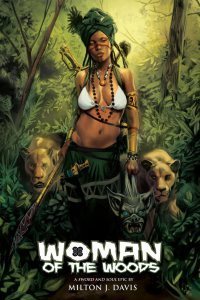 Woman of the Woods, by Milton Davis, introduces us to Sadatina, a young woman of the Adamou nation. For centuries, the Adamou have been under attack by the yoke – dark, ape-like servants of the god Karan. Their only protection has been the Sosa – warrior-women blessed by their god, Cha, to fight the yoke. Even as a young girl, Sedating is stronger and faster and better at hunting and fighting than any of the young men in her village.
Woman of the Woods, by Milton Davis, introduces us to Sadatina, a young woman of the Adamou nation. For centuries, the Adamou have been under attack by the yoke – dark, ape-like servants of the god Karan. Their only protection has been the Sosa – warrior-women blessed by their god, Cha, to fight the yoke. Even as a young girl, Sedating is stronger and faster and better at hunting and fighting than any of the young men in her village.
With the aid of two rhumbas – jungle cats whom she has raised from cubs – Sedating becomes the village’s protector and earns the name “Woman of the Woods”.
Moses: The Chronicles of Harriet Tubman, by Yours Truly, is an exciting mash up of Steam funk, alternate history and horror.
The shero – soldier, freedom fighter, Black Dispatch and monster hunter, Harriet Tubman, is hired by John Wilkes Booth to rescue his child Margaret from kidnappers. Harriet Tubman is a supernatural shero, so she does her job well, but later discovers that Booth is not the girl’s father, which launches the story into a frenzy of action and adventure. The adventure speeds us across the U.S. and Mexico, introducing us to extraordinary characters and exciting scenarios along the way.
Matching Harriet Tubman in power are the murderous Mama Maybelle and the cigar-smoking, gun-toting, ass kicking anti-shero, Black Mary Fields (aka “Stagecoach Mary”).
Harriet Tubman is also one of the sheroes of the Steamfunk feature film, Rite of Passage and its upcoming companion anthology, Rite of Passage: Road to Nicodemus.
There are many more Black heroes in Fantasy and Science Fiction who I will introduce you to in later installments. What women heroes of color are your favorites?


December 7, 2013
A SINGLE LINK IS HERE!
I am excited – and proud – to announce that the action adventure, fight fiction, New Pulp book is available in paperback and ebook!
A Single Link is sure to keep your eyes popped, your jaw dropped and your fingers turning the pages as you step into the cage with Remi Swan, who becomes the first woman to fight against men in professional mixed martial arts on her quest for justice and closure after suffering a brutal assault by a pro fighter.
I loved writing this Rocky meets Enough story, which is filled with heart, grit and pulse-pounding, two-fisted action and I know you’ll love it too!
The action adventure New Pulp novel ” A Single Link” is now available in paperback and ebook!
A Single Link (The WERK Chronicles) (Volume 1): Balogun Ojetade: 9781493740659: Amazon.com: Books


December 3, 2013
A Steamfunkateer encounters Twinjas!
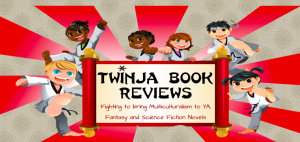 Recently I was interviewed by Twinja Book Reviews, a website dedicated to the fight to bring multiculturalism to Young Adult Fantasy and Science Fiction novels.
Recently I was interviewed by Twinja Book Reviews, a website dedicated to the fight to bring multiculturalism to Young Adult Fantasy and Science Fiction novels.
Founded and helmed by twin sisters Libertad and Guinevere Tomas, Twinja Book Reviews is a great site to find YA books that go beyond the white male default protagonist. Check out their ‘Our Reviews’ section for a wonderful selection of multicultural YA.
Also, check out their site for other exciting interviews to follow. They have a line-up of authors set up you do not want to miss. The schedule can be found on their site here.
I was privileged to be the first interview the sisters conducted. I have reposted it below for your reading pleasure:
My sister and I haven’t had the pleasure of reading any of your books yet, but there has been a lot of buzz surrounding you in various places. It’s like we can’t conduct an online search pertaining to diversity in books without your name being mentioned! Why don’t you tell our readers a bit about yourself, as well as your writing?
I am very grateful for the buzz and I thank everyone for their ongoing support.
For those who don’t yet know me – and I would imagine that’s a lot of folks – I am an author; a father of eight children; grandfather of two; a husband; a Steamfunkateer / Steampunk; a filmmaker; a screenwriter; an actor (sometimes); a creator of role-playing games and a priest in the traditional Yoruba system of Ifa. I am also owner, master instructor and technical director of the Afrikan Martial Arts Institute, which has representatives in Atlanta, Macon, GA, Raleigh-Durham, NC and London, England.
I live and work in Atlanta, Georgia.
I write speculative fiction; mainly, Steamfunk, Sword and Soul, New Pulp and Urban Fantasy.
For those unfamiliar with my work and my writing style, you can check out some of my short fiction on my website at Chronicles Of Harriet .
My published fiction books include my books, Moses: The Chronicles of Harriet Tubman (Books 1 & 2); Once Upon A Time In Afrika; and Redeemer (or, paperback) and I am contributing Co-Editor of the bestselling anthology, Steamfunk and Ki Khanga: The Sword and Soul Anthology. In December, I will release my fight fiction New Pulp novel, A Single Link and in 2014, I will release two novels and one novella and will appear in several anthologies.
We’ve recently discovered the two genres you’ve penned, “Steamfunk” and “Sword and Soul” floating around the realm of diversity in science fiction and fantasy. Why don’t you explain what those genres are?
 Sword & Soul is the African expression of Heroic and Epic Fantasy; think Conan or Lord of the Rings with African heroes, probably in an African setting and featuring African culture and spirituality and you have Sword & Soul. Sword & Soul has been around since the 1970s when the subgenre’s founder, Charles R. Saunders – the masterful author of two incredible Sword & Soul novel series: Imaro and Dossouye – coined the phrase and created a new subgenre of Fantasy.
Sword & Soul is the African expression of Heroic and Epic Fantasy; think Conan or Lord of the Rings with African heroes, probably in an African setting and featuring African culture and spirituality and you have Sword & Soul. Sword & Soul has been around since the 1970s when the subgenre’s founder, Charles R. Saunders – the masterful author of two incredible Sword & Soul novel series: Imaro and Dossouye – coined the phrase and created a new subgenre of Fantasy.
As far as Steamfunk; in order to understand it, we must first give a brief definition of Steampunk. Steampunk is a subgenre of science fiction or fantasy, characterized by a setting – in the past, present or future – in which steam power is the predominant energy source. Think the television show The Wild, Wild West, the graphic novel / comic book series, The League of Extraordinary Gentlemen, or the movie The Golden Compass.
Steamfunk is a philosophy or style of writing that combines the African and / or African American culture and approach to life with that of the Steampunk philosophy and / or Steampunk fiction.
I am one of the founders of the Steamfunk Movement.
On our blog, Twinja Book Reviews, we only review books that feature marginalized groups (e.g. black, gay, Latin, Asian, disabled, plus sized) Why you ask? Well, because then our book blog would be lost in the sea of other book blogs! And why not spread the word on how much we’d like to get our message out there, to perhaps encourage authors to write diverse fiction and for readers to demand it! Why is Diversity in Science fiction and fantasy important to you?
 First and foremost, I have been a fan of Science Fiction and Fantasy since I was two years old. In fact, I learned to read at two because my sisters introduced me to superhero and Archie comic books at that age.
First and foremost, I have been a fan of Science Fiction and Fantasy since I was two years old. In fact, I learned to read at two because my sisters introduced me to superhero and Archie comic books at that age.
I learned just how important Science Fiction and Fantasy is after spending several years as an English and Creative Writing teacher in the public and private sectors. In conversing with other English teachers, I often asked them if they taught creative writing in their classes. Most did not. One teacher told me that she tried “that creative writing stuff” with her students, but quickly gave up on it and returned to a more “practical syllabus”. Upon further investigation, I discovered that she believed creative writing – particularly Horror, Science Fiction and Fantasy – to be something outside – and, indeed, beneath – the instruction of English.
Most educators of English / Language Arts focus on the mechanics of the subject – how to read and write, rules of grammar, use of verbs, adverbs, adjectives, pronouns and nouns and sentence comprehension – without the context of why and how those mechanics are used by students to express themselves.
Yes, we need to teach the mechanics – how to hold a pen; how to read; how words work – but we should not confuse use of a thing with understanding of it. Training in the mechanics of writing produces writing technicians; however, it does not make you a writer. So, you know how to spell; you can answer questions on grammar; you can repeat someone else’s literary criticism of a text – you are a technician. You can fix my text as a garage mechanic can fix my car. The garage mechanic can’t design a car. They can’t improve a car. They can’t build one from scratch. They can only ever work on someone else’s car.
This is why we – and our children – need to read and to write Science Fiction and Fantasy – so that our children do not only work on other people’s texts; they create and build their own. So they are not limited to just reading a story written by someone else and providing a report on it – they are out there in the field, experimenting with new stories and questioning old ones…if only for the reason that they can.
We need to teach our children to go out into the world to add to the pantheon of human creation and endeavor, not to dissect the words of long dead men. Science Fiction and Fantasy are best suited for that.
So, your latest book, Moses: The Chronicles of Harriet Tubman, features Steampunk elements (Or, as you say, Steamfunk) and Harriet Tubman as the Main Protagonist. You have to share what was going through your mind when you came up with that idea!
 Actually, Moses: The Chronicles of Harriet Tubman (Book 1) is my first fiction book. It was released as an e-book in 2011 through Mocha Memoirs Press. In July 2012, I released Moses: The Chronicles of Harriet Tubman (Books 1 & 2) in paperback under my own publishing and film production company, Roaring Lions Productions. I am now writing books 3 and 4 in the series.
Actually, Moses: The Chronicles of Harriet Tubman (Book 1) is my first fiction book. It was released as an e-book in 2011 through Mocha Memoirs Press. In July 2012, I released Moses: The Chronicles of Harriet Tubman (Books 1 & 2) in paperback under my own publishing and film production company, Roaring Lions Productions. I am now writing books 3 and 4 in the series.
Harriet Tubman is one of my heroes. I think because my mother, who is at the top of my list of heroes, is so much like Harriet Tubman, I fell in love with “General Moses” at a young age and I continue to love and admire her. I knew, long ago, that the first novel I wrote would have Harriet Tubman as the hero. I also knew that the world would be similar to that found in The Wild, Wild West – one of my mother’s favorite television shows; a show she made me fall in love with – but a bit grittier; a bit more fantastical.
What type of research goes into bringing one of your stories to life?
 Tons of research…on the history; on the setting; on the culture and belief system of the people I write about.
Tons of research…on the history; on the setting; on the culture and belief system of the people I write about.
If we are going to write Steampunk and our story is set during the Victorian Era (between 1837 and 1901) and we want to avoid the cultural appropriation so prevalent in Steampunk, then it is necessary that we know history; that we understand how the Age of Steam was, so that we can determine how it should have been.
If we cosplay a “Steampunk Squaw”, we should research how First Nation women lived during the Age of Steam; we should study First Nation cultures and choose in which nation we are going to gain historical and sociological expertise; we should research the word “squaw”, understand it is an offensive term to First Nation women and change the name…if you give a damn.
And that is what research is: giving a damn. So I do it…a lot.
What are some of your biggest challenges as a writer of Color?
The biggest challenge is letting people know that there are great works of Science Fiction and Fantasy by People of Color out there. Many more People of Color would read Science Fiction or Fantasy if they knew there are heroes in our books who look like them; who act, think and feel like them.
For years, we were the noble savage; the magical negro; the yellow menace. No one wants to invest days, weeks and sometimes even months, reading how less beautiful they are; how less intelligent; how less heroic. And mainstream publishes continues to perpetuate these images.
That is why I am convinced that the future of the literary industry is in independent publishing – small press and self-publishing. The mainstream literary industry is rooted in fear. It, like any corporation, is not in the business of taking risks – and Black books, other than street lit, are considered risky business.
Books with People of Color as the heroes and sheroes are risks and the mainstream rarely wants to touch these books; and if they do, you are often asked to change your hero to a Caucasian male or they whitewash your cover, changing your Person of Color into a swarthy White person. Now, once an indie author creates a lot of buzz, the mainstream might pick them up, but before that, chances of your work getting published are slim. If your hero is Black, your chances are even slimmer and if your book is about Black on Black love, you can forget it. That is why I only work with independent publishers and I also self-publish.
I think one thing We love about your book covers is that they feature African American Women of a darker shade (Nothing against the lighter shades but you have to admit darker skinned women on book covers RARELY happens). I think the trend today is to write characters Bi-racial because some feel a black character is not as relatable as a bi-racial one that shares some European heritage. Do you think Colorism and the media’s narrow minded idea of beauty play a big role in the lack of black (especially darker skinned ones) characters on the front covers of books?
 I think the media is well aware of the beauty black people possess, however, for so long, the “beauty and magnificence of whiteness” has been fed to us through the media that now it is a risk to show otherwise and like I stated earlier, the media, like any other corporation, is not in the business of taking risks.
I think the media is well aware of the beauty black people possess, however, for so long, the “beauty and magnificence of whiteness” has been fed to us through the media that now it is a risk to show otherwise and like I stated earlier, the media, like any other corporation, is not in the business of taking risks.
People who take risks; people who stand up and say “I am going to tell these stories about Black people unapologetically” – scare many white people. Hell, we scare many Black people too, who fear it is best to just get along. We scare the mainstream and those working within it because we show that we can be successful without the mainstream and we can do this our way.
In terms of diversity, you feature A LOT of characters of African descent (which is totally stellar). Do you plan on including other marginalized groups in future writings (e.g. Afro-Latina/ Latino characters; I ask because we’re both black Latinas) or Asian love interests?
I do include a diverse cast of characters in my books – and many Latinos / Latinas are of African descent, as I am sure you know – however, my main heroes and sheroes will always be of African descent. In my Steamfunk story, Nandi, which is set in 1970s California, the hero, Nandi, a law-enforcement officer who hunts the supernatural, is a Black woman, born in America, but with strong ties to Africa; her partner Pei-Pei Ming, is Chinese and her former lover, Wabli Ska, who is a law-enforcement officer, turned anarchist, is Native American.
I write what I want to see. I want to see more Black-on-Black love, so I write that; I want to see Black people on amazing adventures and being heroic, so I write that. I believe that most people want to see themselves as the hero. If they have the ability to create worlds in which they are that – through fiction, film, illustrations, or some other medium, they should do so.
What are some areas or themes you haven’t yet covered but would like to in future writings?
I don’t believe in waiting. If I want something done, I do it, so I have now dived head first into writing New Pulp. I am also writing a Rococoa pirate novel, Black Caesar: The Stone Ship Rises. Rococoa is similar to Steampunk, but is set in the era in which clockwork technology is dominant. Think DaVinci’s Demons, The Three Muskateers, or Brotherhood of the Wolf, told from a Black perspective.
All of these new writings will be published next year.
Where can potential readers learn more about you and your current and future works?
You can learn more about me and my works by visiting my website – Chronicles Of Harriet – or to learn more about the Steamfunk feature film I wrote, directed and fight choreographed, based on a short story written by author Milton Davis, visit Rite of Passage, The Movie.
This amazing movie, entitled, Rite of Passage, will premiere in February, 2014 and is scheduled to screen at major film festivals and fan conventions worldwide.
You can also friend me on Facebook @ Balogun Ojetade; or follow me on Twitter @ Baba_Balogun
I am also quite active on Tumblr @ Black Speculative Fiction and Pinterest @ Balogun


November 29, 2013
Make it a REAL “Black” Friday!
Buy Black Speculative Fiction!
Also, try out these Blacktastic Books you will absolutely love:
Imaro by Charles Saunders – A masterwork from the father of Sword and Soul. Imaro is the definition of great Heroic Fantasy.
The Parable of the Sower by Octavia E. Butler – Widely considered Butler’s best work, this is an incredible story of a dystopian future and a heroine with hyper-empathy.
Immortal by Valjeanne Jeffers – The first in a series of exciting books that takes place in the world of Tundra. Jeffers deftly combines Science Fiction, Horror and Romance in telling the story of Karla, a shapeshifter who fights the forces of evil of which she dreams.
Wind Follower by Carole McDonnell – This epic fantasy romance explores race, ethnicity, and imperialism in a beautiful – and sometimes brutal – ancient African setting.
A Darker Shade of Midnight by Lynn Emery – Mystery, Horror and Romance combine to give you this masterpiece that is a first in an incredible series. LaShaun Rousselle – the protagonist, who uses her paranormal abilities to solve the mystery of who killed her cousin and what lives in the woods on her family’s land – is one of the most interesting heroine’s in fiction.
Order of the Seers by Cerece Rennie Murphy – This thrilling tale of discrimination, love, retribution, lust for power and the great potential that lies dormant in us all follows the life and struggle of Liam and Lilith Knight – a brother and sister duo who are hunted by a ruthless and corrupt branch of the U.N., which seeks to capture and exploit Lilith’s unique ability to envision the future.
Hayward’s Reach by Thaddeus Howze – a series of short stories told by Mokoto, the last survivor of an unexpected cataclysm. Mokoto, even in his current state of in-humanity, learns what it means to be truly human.
Steamfunk edited by Milton Davis and Balogun Ojetade – This is the definitive work of Steamfunk – a philosophy or style of writing that combines Black culture and approach to life with that of the steampunk philosophy and / or steampunk fiction – featuring fifteen masterfully crafted stories by fifteen amazing authors.
Woman of the Woods by Milton Davis – A powerful Sword and Soul tale, set in Davis’ intriguing Uhuru universe, first experienced in his seminal series, Meji. Woman of the Woods draws us into the world of demon-hunter, Sadatina and her “sisters”, a duo of twin lionesses who aid her in her battle against the vicious Mosele and their demon allies, who seek to destroy her people.
Redeemer by Balogun Ojetade – This is an edge-of-your-seat adventure that is both gangster saga and science fiction epic. A tale of fatherhood and of predestination versus predetermination. An entertaining mash-up that Science Fiction, Urban Fantasy and Urban Fiction fans alike will enjoy.
If you are interested in finding more authors of Black Speculative Fiction check out Black Speculative Fiction Reviews.






